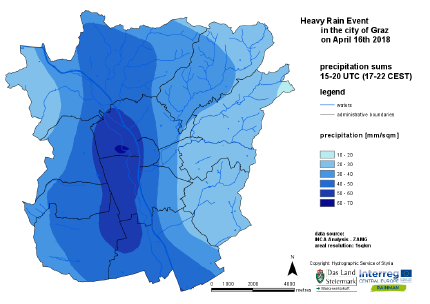Heavy Rain Event in Graz
On the 16th of April the area of Graz was hit by a convective cell which caused heavy rain and local flooding. The storm lasted almost 5 hours and brought over 90 litres of rain per square metre. A rain gauge in the city center registered a peak intensity of over 60 litres per hour per square metre (ZAMG data provided by our project partner Office of the Styrian Government). The storm cell itself was visible on the precipitation radar at 15 UTC south of Graz at much lesser precipitation intensities and intensified when it reached the city of Graz at 16 UTC (Kachelmannwetter).

precipitation sums derived from a combination of radar and rain gauge data
The distribution of rainfall over the city of Graz was very heterogenous, as the above map indicates. Deviations of the total rain amounts compared to the above-mentioned rain gauge data stem from the systematic underestimation of radar rainfall estimations.
Not only in the city center but also in the wider area around Graz, the fire brigade had to tackle with sewer flooding, flooded underpasses and flooded cellars. For example, the basement as well as the underground car park of the shopping center "Citypark" in Graz were inundated. Airplanes were redirected to the airport of Vienna. Event information was researched via the European Severe Weather Database.
Mor event related information and pictures can be found here:
https://www.youtube.com/watch?v=GLBLnceD98w
http://steiermark.orf.at/news/stories/2907343/
This is a typical situation which might occur at many other places. The ZAMG, the meteorological service of Austria, issued a severe weather warning for Styria for this day. A radar based alarm tool for flash floods from the private weather service Kachelmannwetter indicated the risk for flash floods at 16:05 UTC exactly as the storm hit the city center of Graz. Thus, observation-based warnings are of limited use regarding the lead time for civil protection organisations.
With almost no time to warn, local and regional authorities have to cope with heavy rain events. This proves once again the great importance of Heavy Rain Risk Management and a proper Risk Communication!
